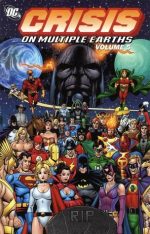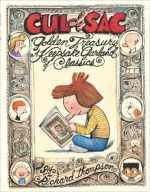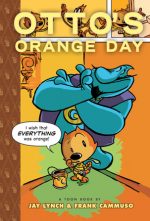
By Gerry Conway, Dick Dillin, George Perez, Frank McLaughlin & various (DC Comics)
ISBN: 978-1-4012-2623-7
In my most relaxed moments I am at heart a child of the Silver Age. The material I read as a kid shaped me and I cannot honestly declare myself a completely impartial critic on comics of the time. The same probably applies to the brave and bold continuances that stretched all the way to the 1980s recreation of Marvel, DC and the rest of America’s costumed champions.
That counts doubly so for the Julie Schwartz edited Justice League of America and its annual summer tradition of teaming up with its progenitor organisation, the Justice Society of America. If that sounds a tad confusing there are many places to look for clarifying details. If you’re interested in superheroes and their histories you’ll even enjoy the search. But this is not the place for that.
Ultra-Editor Schwartz ushered in the Silver Age of American Comics with his landmark Showcase successes Flash, Adam Strange and Green Lantern, directly leading to the JLA which in turn inspired the Fantastic Four and Marvel’s entire empire; changing forever the way comics were made and read…
Whereas the 1940s were about magic and macho, the Silver Age polished everything with a thick veneer of SCIENCE and a wave of implausibly rationalistic concepts which quickly filtered into the dawning mass-consciousness of a generation of baby-boomer kids.
The most intriguing and rewarding was, of course, the notion of parallel worlds…
Once DC’s Silver Age heroes began meeting their Golden Age predecessors from “Earth-2â€, that aforementioned annual tradition commenced: every summer the JLA would team-up with the JSA to combat a trans-dimensional Crisis…
This volume reprints magnificent mass-gatherings encompassing Justice League of America #159 & 160 (October – November 1978), #171-172 (October – November 1979) and #183-185 (October to December 1980); a transitional period which saw comic book tastes changing as sales dwindled. It also marks the passing of a true great…
The amazing fantasy opens with a time-bending threat as five legendary warriors are plucked from history by a most malevolent malefactor for the most noble of reasons. They are then pitted against the greatest superheroes of two worlds in ‘Crisis from Yesterday’ by scripter Gerry Conway and artistic dynamic duo Dill Dillin & Frank McLaughlin.
In his zeal to conquer and plunder, the nefarious Lord of Time has accidentally created an omnipotent super-computer that is counting down to stopping the passage of time forever. Unable to halt or avoid the cosmic disaster, the temporal terrorist extracts Jon, the Viking Prince, English freebooter Black Pirate, Revolutionary War heroine Miss Liberty, western gunman Jonah Hex and WWI German fighter ace Hans von Hammer; supercharges them with eerie energies and programs them to attack the united Justice League and Society.
The Time Lord’s logic is simple: after suffering a shattering defeat, the teams – fired with determination and righteous fury – will promptly track him down, invade his Palace of Eternity and destroy for him his unstoppable computer. Or at least the survivors will…
Surprisingly that convoluted plan seems to work out in the concluding ‘Crisis from Tomorrow!’ but only after the chronally kidnapped quintet overcome their perfidious programming and revert to their true valiant selves. Even as the beleaguered superhero teams sacrifice everything to thwart the Lord of Time, the time-lost warriors prove their mettle against the errant computer.
One year later, the annual scenario hosted a savage locked-room mystery as ‘The Murderer Among Us: Crisis Above Earth One!’ sees the JLA feting the JSA in their satellite HQ and horrified to find one of their veteran guests throttled by unseen hands.
With no possible egress or exit, the greatest detectives of two Earths realise one of their heroic compliment must be the cold-blooded killer. Soon a methodical elimination of suspects leads to tense explorations and explosive repercussions in the revelatory finale ‘I Accuse…’
With the next summer’s team-up an artistic era ended as criminally underappreciated illustrator Dick Dillin passed away whilst drawing the saga. He and McLaughlin only completed Conway’s first chapter – ‘Crisis on New Genesis or, Where Have All the New Gods Gone?’ – of an epic confrontation between JLA, JSA and futuristic deities of Jack Kirby’s astounding Fourth World, leaving up-and-coming star George Pérez to fill some very big boots (and gloves and capes and…).
In the first chapter, the assembled heroes are unilaterally shanghaied out of the regular universe and transported to trans-dimensional paradise planet New Genesis. The world is utterly deserted but for a furiously deranged Orion who seems set on crushing them all. Happily he is stopped by late-arriving Mister Miracle, Big Barda, Oberon and Metron who reveal their fellow gods have been captured and sent to hell-world Apokolips by three Earth-2 villains…
The place has been in turmoil since evil overlord Darkseid was killed by Orion and in the interim the vanquished devil’s spirit has travelled to Earth 2 and recruited The Shade, Icicle and Fiddler to resurrect him…
The details of the scheme are reviewed in ‘Crisis Between Two Earths or, Apokolips Now!’ as the freshly restored Darkseid strives to make his still-tenuous existence permanent and the heroes split up to stop him by hitting key components of his technology and support teams.
Along the way they encounter a resistance movement of battle-scarred super-powered toddlers, the horrific reason the New Genesisians were initially taken and how Darkseid plans to invade the natural universe by cataclysmically transporting Apokolips the space currently occupied by Earth-2…
The diabolical denouement reveals a ‘Crisis on Apokolips or, Darkseid Rising!’ as the scattered champions reunite to stop the imminent catastrophe and set the worlds to rights in an explosive clash with no true resolution. Such is the nature of undying evil…
With full biographies of the creators and a stirring cover gallery by Rich Buckler, Dick Giordano, Dillin, McLaughlin, Jim Starlin & Bob Smith, this a sheer uncomplicated dose of nostalgic delight for those who love costumed heroes, crave carefully constructed modern mythologies and care to indulge in a grand parade of straightforward action, great causes and momentous victories.
These are instantly accessible yarns: captivating Costumed Dramas no lover of Fights ‘n’ Tights fun and frolics could possibly resist. And besides, surely everyone fancies finding their Inner Kid again?
© 1978, 1979, 1980, 2010 DC Comics. All Rights Reserved.










